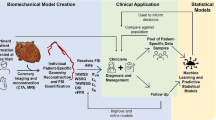Abstract
The aim of this study was to elucidate flow patterns of two different types of aortic cannulas inserted from the ascending aorta toward the aortic arch and root by mock circulation in a normal aortic arch and an aortic arch aneurysm model. Extracorporeal circulation was established using a centrifugal pump, a transparent glass normal aortic arch model, and an aortic arch aneurysm model for measurement by particle image velocimetry. The Stealthflow and Dispersion cannulas were used to elucidate the characteristics of the flow pattern and velocity under the condition of the cannula tip toward the aortic arch and aortic root. In the normal aortic arch model, high-velocity exit flow ranging from 0.7 to 0.8 m/s was detected in the proximal aortic arch by directing the cannula tip toward the aortic arch, whereas flow velocity in the aortic arch was < 0.2 m/s by directing the cannula tip toward the aortic root. In the aortic arch aneurysm model, high-velocity exit flow ranging from 0.5 to 0.8 m/s was detected in the aortic arch by directing the cannula tip toward the aortic arch, whereas flow velocity in the aortic arch was decreased to less than 0.2 m/s by directing the cannula tip toward the aortic root. Directing the aortic cannula tip toward the aortic root allowed the high-velocity exit flow to attenuate in velocity, so that flow velocity in the aortic arch was sufficiently reduced by reversed flow and vortex formation in both the normal and aortic arch aneurysm models.







Similar content being viewed by others
References
Costa MA, Gauer MF, Schafranski MD, et al. Risk factors for perioperative ischemic stroke in cardiac surgery. Rev Bras Cir Cardiovasc. 2015;30:365–72.
Goldstone AB, Bronster DJ, Chikwe J, et al. Predictors and outcomes of seizures after cardiac surgery: a multivariable analysis of 2,578 patients. Ann Thorac Surg. 2011;91:514–8.
Filsoufi F, Rahmanian PB, Adams DH, et al. Incidence, imaging analysis, and early and late outcomes of stroke after cardiac valve operation. Am J Cardiol. 2008;101:1472–8.
Fukuda I, Minakawa M, Suzuki Y, et al. Breakdown of atheromatous plaque due to shear force from arterial perfusion cannula. Ann Thorac Surg. 2007;84:e17–8.
Muehrcke DD, Cornhill JF, Cosgrove DM, et al. Flow characteristics of aortic cannulas. J Card Surg. 1995;10:514–9.
Goto T, Inamura T, Ito K, et al. Hydrodynamic evaluation of a new dispersive aortic cannula (Stealthflow). J Artif Organs. 2016;19:121–7.
Goto T, Fukuda I, Minakawa M, et al. Clinical evaluation of a new dispersive aortic cannula. Perfusion. 2021;36:44–9.
Grooters RK, Thieman KC, Nelson MG, et al. Assessment of perfusion toward the aortic valve using the new dispersion aortic cannula during coronary artery bypass surgery. Tex Heart Inst J. 2000;27:361–5.
Minakawa M, Fukuda I, Inamura T, et al. Effect of cannula shape on aortic wall and flow turbulence: hydrodynamic study during extracorporeal circulation in mock thoracic aorta. Artif Organs. 2007;31:880–6.
Blauth CI, Cosgrove DM, Loop FD, et al. Atheroembolism from the ascending aorta. An emerging problem in cardiac surgery. J Thorac Cardiovasc Surg. 1992;103:1104–11.
Wareing TH, Davila-Roman VG, Kouchoukos NT, et al. Management of the severely atherosclerotic ascending aorta during cardiac operations. A strategy for detection and treatment. J Thorac Cardiovasc Surg. 1992;103:453–62.
Weinstein GS. Left hemispheric strokes in coronary surgery: implications for end-hole aortic cannulas. Ann Thorac Surg. 2001;71:128–32.
Minakawa M, Fukuda I, Inamura T, et al. Hydrodynamics of aortic cannulas during extracorporeal circulation in a mock aortic arch aneurysm model. Artif Organs. 2010;34:105–12.
van der Linden J, Hadjinikolaou L, Lindblom D, et al. Postoperative stroke in cardiac surgery is related to the location and extent of atherosclerotic disease in the ascending aorta. J Am Coll Cardiol. 2001;38:131–5.
Minakawa M, Fukuda I, Hashimoto H, et al. Hydrodynamic evaluation of axillary artery perfusion for normal and diseased aorta. Gen Thorac Cardiovasc Surg. 2008;56:215–21.
Fukuda I, Fujimori S, Inamura T, et al. Flow velocity and turbulence in the transverse aorta of a proximally directed aortic cannula: hydrodynamic study in a transparent model. Ann Thorac Surg. 2009;87:1866–71.
Acknowledgements
This study was supported by JSPS KAKENHI Grant Number 24592044.
Author information
Authors and Affiliations
Contributions
All authors have made substantial contributions to all of the following: TG, IF, and MM conception and design of the study. TG acquisition of data. TI and MS analysis and interpretation of data. TG, MM, and IF drafting the article or revising it critically for important intellectual content. Final approval of the version to be submitted.
Corresponding authors
Ethics declarations
Conflict of interest
Dr. Ikuo Fukuda is an inventor of the Stealthflow cannula. All other authors declare that they have no conflict of interest.
Additional information
Publisher's Note
Springer Nature remains neutral with regard to jurisdictional claims in published maps and institutional affiliations.
Rights and permissions
About this article
Cite this article
Goto, T., Fukuda, I., Inamura, T. et al. Flow analysis during mock circulation in normal and aortic arch aneurysm models through an aortic cannula toward the aortic arch and root. J Artif Organs 24, 442–449 (2021). https://doi.org/10.1007/s10047-021-01267-3
Received:
Accepted:
Published:
Issue Date:
DOI: https://doi.org/10.1007/s10047-021-01267-3




